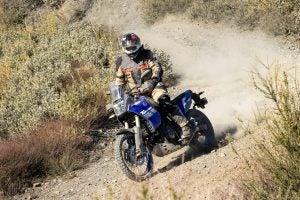Adventure bikes and dual-sport machines were all over the place at the big EICMA moto show in Italy this year, and there were a few other surprises if you poked around to find them, so I went poking across the six massive EICMA exhibition halls in Milan. Here’s what caught my eye at the big annual Milan motopalooza.
First off, Honda’s new XL750 Transalp seems to be on everyone’s wish list, especially accessory makers. Does anyone doubt Big Red’s modern resurrection of the cult classic will be a force to be reckoned with in the middleweight adventure bike division? I don’t. There were full-on Transalp-specific accessory kits on display from big hitters including this soft set of SW Motech mini panniers:

SW Motech, best known for the hard panniers, showed off a complete soft bag system for the Transalp. Photo: William Roberson
Tourtech had this full hard/soft bag setup, bash plate, crash bars and yellow wrap:

Photo: William Roberson
Acerbis showed off this colorful tank and bodywork kit and soft bag, plus a riding suit:
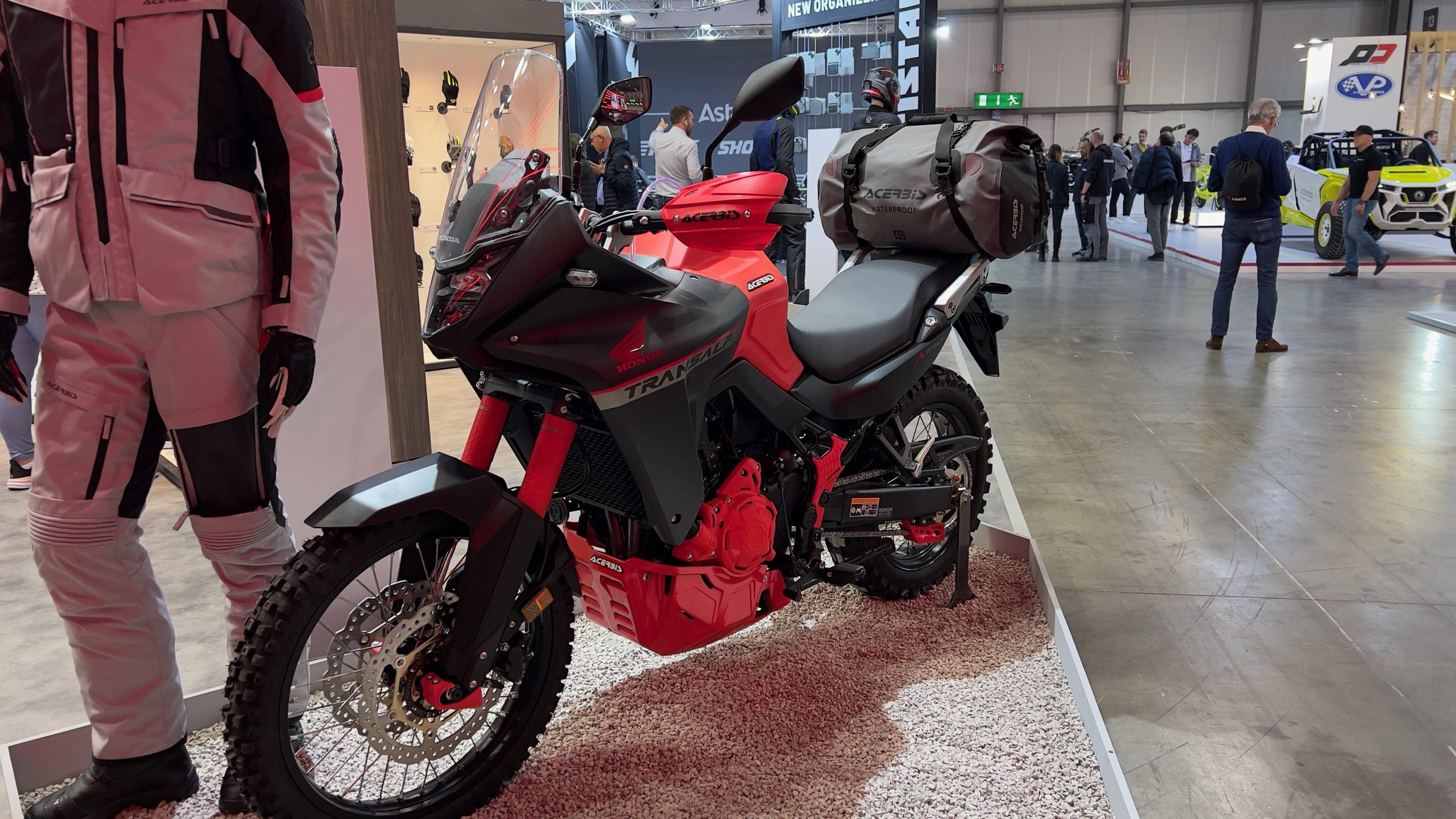
Photo: William Roberson
Case maker Shad had a slick triplet of hard bags and tank bag on display:

Photo: William Roberson
And Givi was not about to be left out with this sweet and spacious Canyon soft setup:
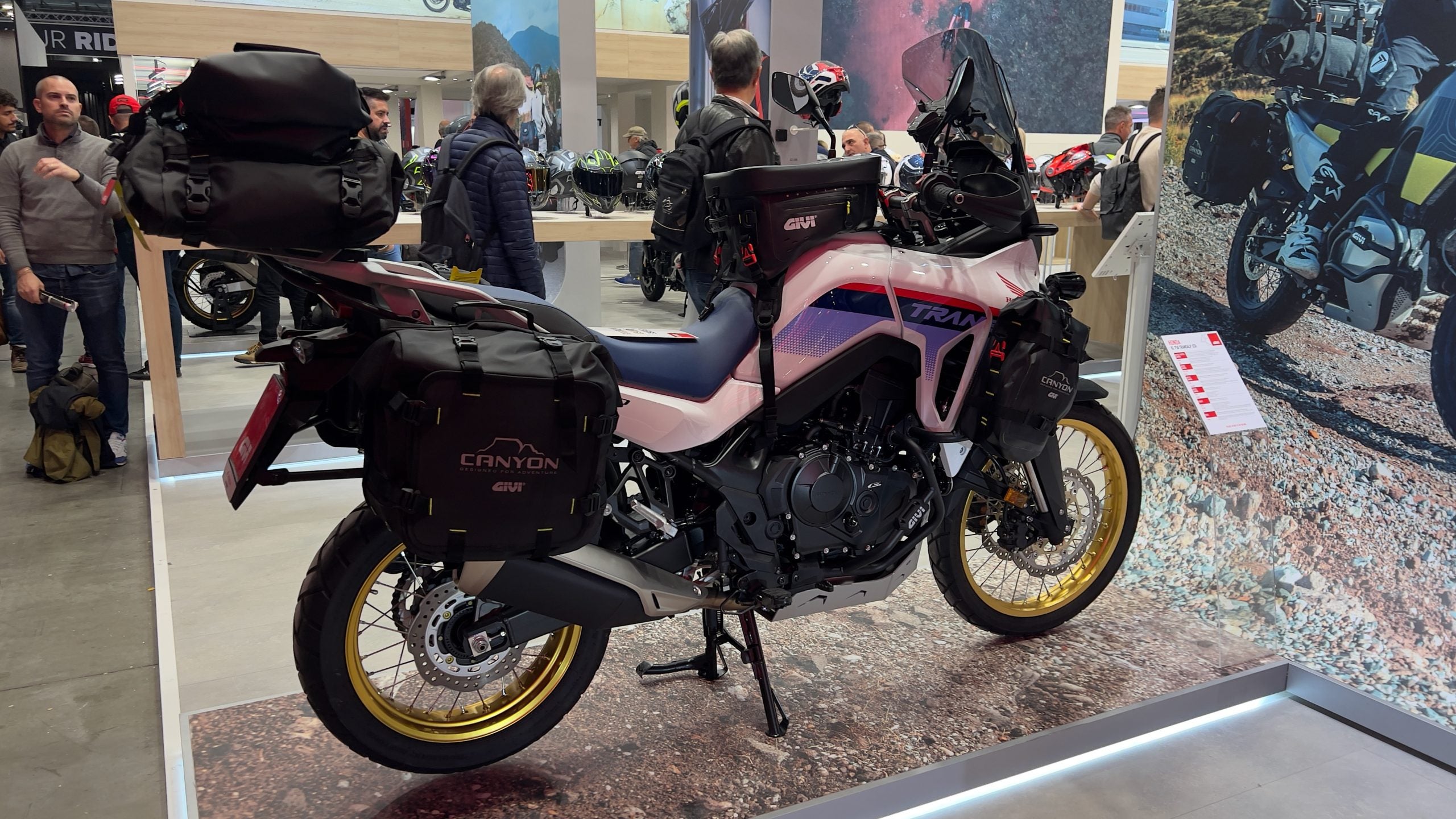
Photo: William Roberson
New Transalps were all over the place! Granted, the Eurozone had the original Transalp literally for decades while US riders only had a two-year window to grab one, so they are more familiar with the machine. But for this American, it seemed like the new Honda was just everywhere at the show. Here’s hoping it at least justifies the hype when we throw a leg over it for a ride review.
Everyone Is Going to The ADV Party
Beyond a Transalp around every corner, it was clear that ADV-type bikes and dual-sports in general are more popular than ever, and more companies are trying to get in on the hot sales action. I mean, even this Vespa was ready to hit the Baja dunes.

Moto Revolution spiced up this Vespa GTS with a few ADV bits. Photo: William Roberson
Well, maybe not to that extent, but ADVed scooters are now a definite thing. I lost count of the Honda ADV160/350 wannabes I saw but the trend makes sense. I rented a Vespa 125 to see the sights in Milan and the roadways are downright hazardous to regular scooters in many places, especially with stock suspension. But scoots with larger wheels and/or ADV type setups clearly faired far better. Go for a ride to see what I mean, like the roads (and rails!) at :50 and beyond:
So it was interesting to see the proliferation of ADVed scooters at the show, like this one from Aprilia (below) sporting crash bars, aux lights and larger, dirt-worthier wheels and tires. Will it be ridden off-road? As I quickly learned while riding in India this past year, “roads” in many places – US included – are often a mix of pavement, dirt, mud, sand, and whatever local animals have left behind, but scooters are still a highly efficient way to get around and sell in the millions, so blending in some ADV tech is a pretty smart move.
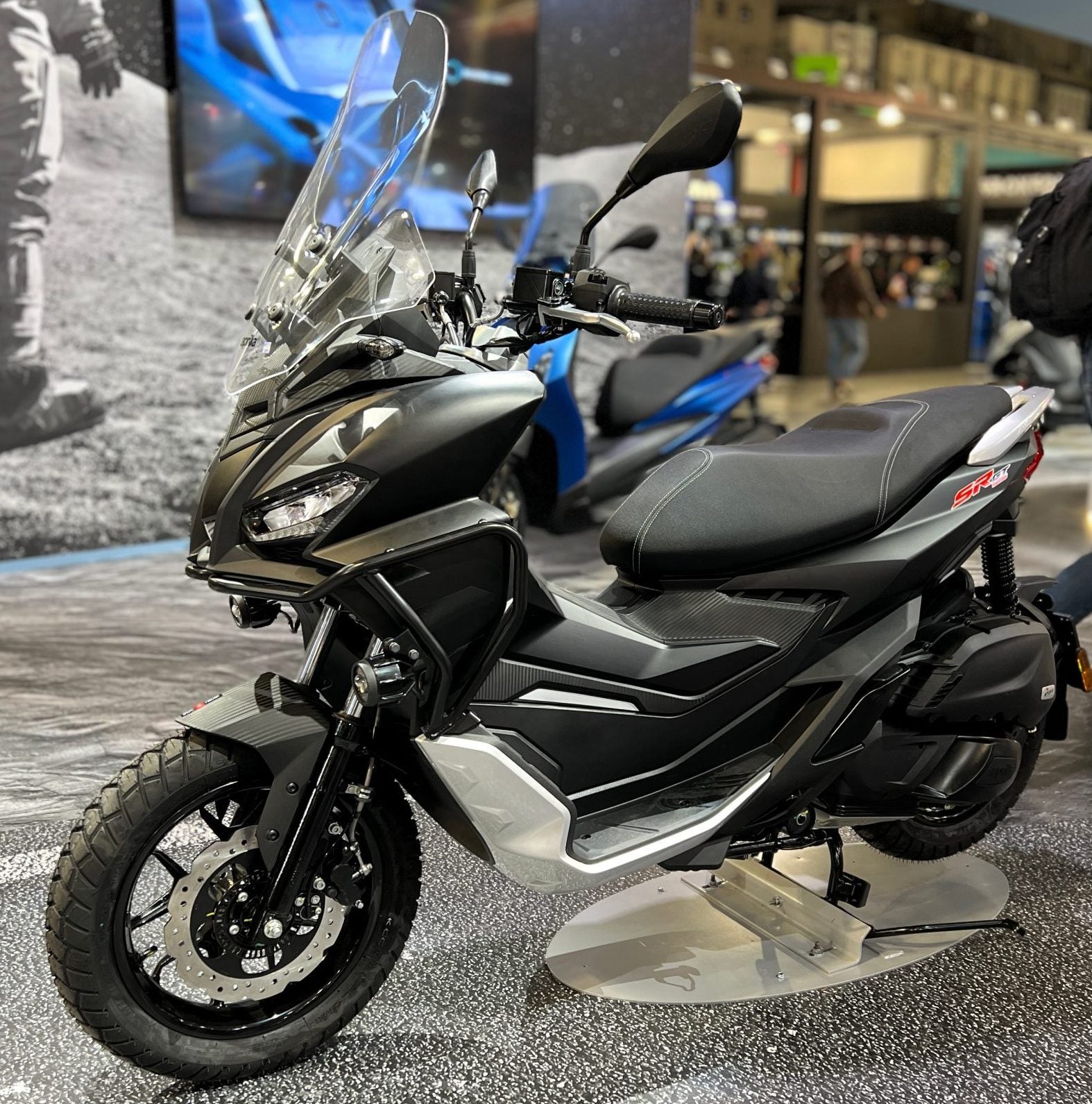
Photo: William Roberson
Beyond dirt scoots, the 450 cc dual-sport displacement class is particularly popular now as it continues to rapidly mature into the “best size for everything” role 650cc machines seemed to dominated only recently. A modern 450 single now has enough juice for at least tolerable open-highway speeds while being lighter and more nimble than the 650 cc and 700/800/900 cc subcats – but they are also substantially more powerful than the sub-400 and 300 cc class bikes. This was evident by the keen interest I saw in two new bikes at the show, Royal Enfield’s new clean-sheet Himalayan 450 and the 450 Rally line from Chinese motorcycle maker KOVE.

A farkled Royal Enfield 450 Himalayan at the company’s EICMA display. It’s impressive. Photo: William Roberson
The new Himi 450 we’d been expecting, but it was almost impossible to get a clean photo of it as it was constantly mobbed with attendees trying to get a closer look. Why so much interest? Royal Enfield hooked a lot of first-time and perhaps unintentional adventure riders with the old-tech (but very sturdy) 411 Himalayan, which nicely blended vintage air-cooled torquey thumper motor technology with suspension that could at least let riders wander down gravel and forest roads with a measure of confidence (given the right tires).
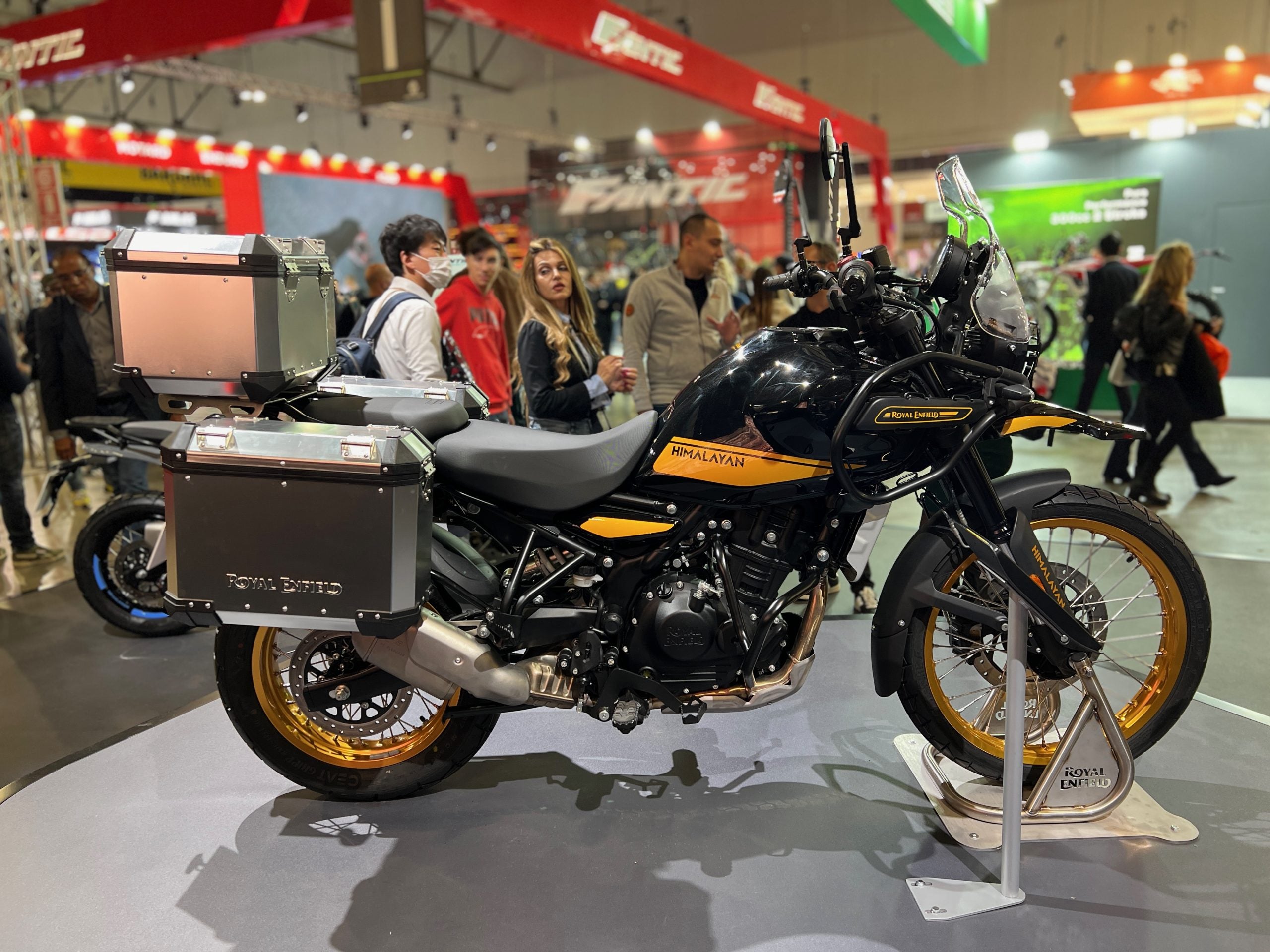
Side view of the new 450 Himi. Photo: William Roberson
Yet out on paved roads it was friendly and reliable, if not exactly a match for some US superhighway speed limits. The new liquid-cooled 450 nearly doubles up the power output in both horsepower and torque categories while adding a sixth cog for highway riding, real-deal suspension and much more modern ADV architecture for adding all the gear we need (or want) to bring. It also marks a massive technological pivot to liquid cooling for Royal Enfield, which has been making only finned cylinders since 1901.
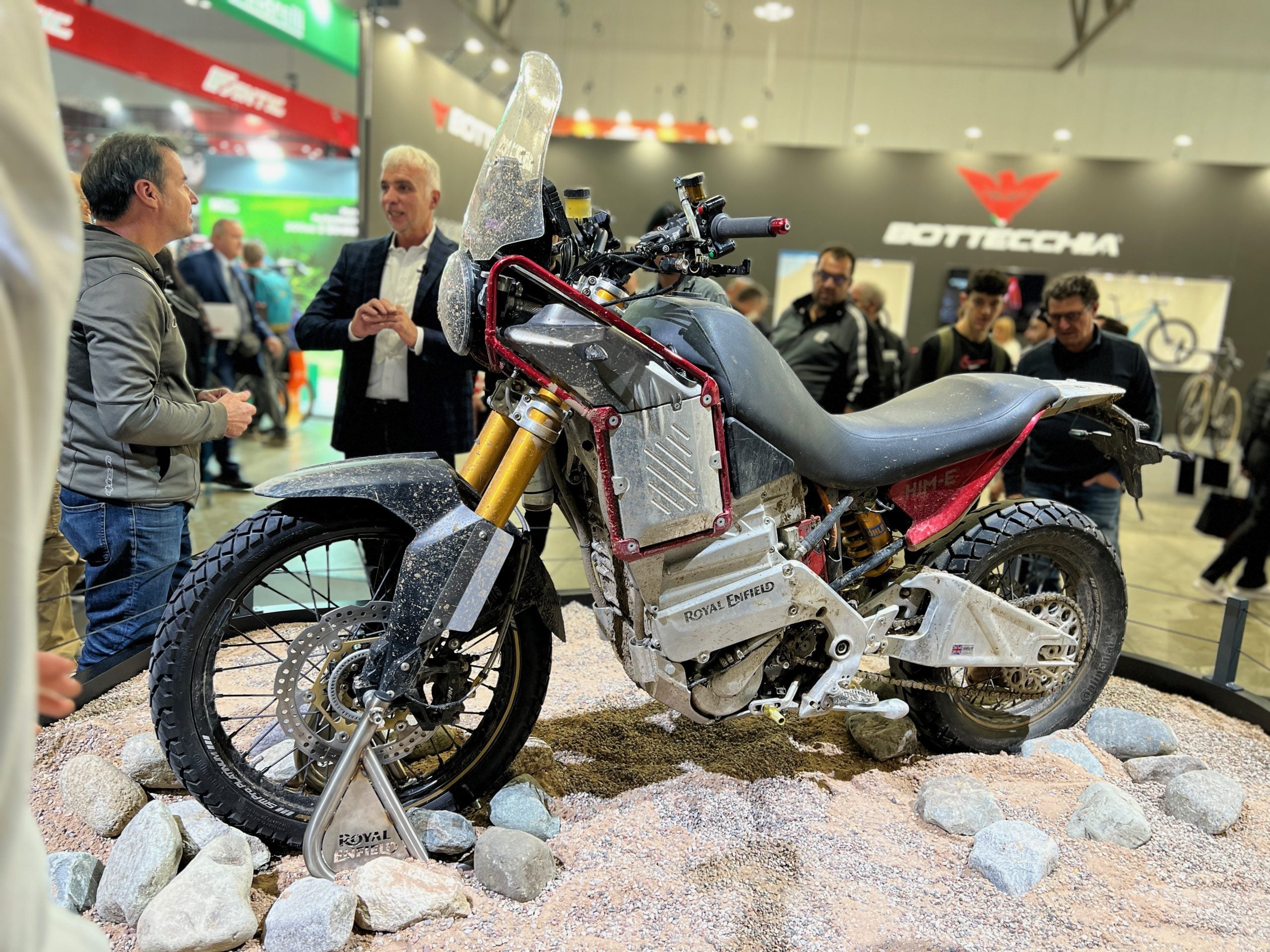
The all-electric ‘Him-E’ looked like it had some miles on it. Photo: William Roberson
And props to Royal Enfield for plopping their prototype electric Himalayan prototype (above) down right next to the new 450. It’s a tech exercise for now, but it clearly shows Royal Enfield has its eye on the future while still preserving their air-cooled heritage with the Twins and Classic model lines.

KOVE 450 Rally Factory Edition looks the business. Would you be tempted? It was a very popular bike at the show. Photo: William Roberson
The street-legal Kove FSE 450R Rally ‘Regular Edition‘ seen above and in the top photo is another thing almost altogether. Crowds constantly poked and prodded it, making it tough to get a snap. The bike looks like it means business and Kove has entered the competition versions in the 2024 Dakar Rally with American rider and 2023 Dakar Stage 2 winner Mason Klein at the controls (he was on a KTM 450 in the 2023 race).

An attendee saddles up the Kove 450. Photo: William Roberson
Kove ran three bikes in the 2023 Dakar rally and while they didn’t win, all three bikes and riders finished the very demanding course. Kove founder and experienced off-road rider Zhang Xue says he wants to win the Dakar race outright in the near future, a high bar for a motorcycle maker founded in 2017. But the 450R Rally Factory Edition and Rally EX competition machine show they mean business.
The 450R Rally EX is indeed a race-only model, with a full foot of suspension travel, three gas tanks including a tail tank that total six gallons of capacity, 56 horsepower from the 452cc DOHC liquid cooled single, sub-300 pound dry weight, a route book in the tower as stock, and a long list of other goodies. Xue has said he hopes to have a street legal version in the near future, but for now it offers a somewhat defanged (51 hp) version for street riders, the Kove 450 Rally “Regular Edition.”
And while we know (and read) the comments about Chinese brands, we also get a feeling of inevitability about the motorcycles coming from beyond the Great Wall. In street trim, the Kove 450 still looks the business and makes 51 horsepower and 30 lb-ft of torque – not far off its racing tune numbers and reportedly for a buck under $9,000.
With Chinese companies now making motors for various KTM, BMW, Honda models and other brands, is it any wonder the standards and tech have risen? We understand the political and ideological pushback against Made in China motorcycles, but with our ever-present smartphones, computers and many staples of daily life flowing from the People’s Republic without much complaint, why is it that motorcycles (and cars) are met with such resistance? In Italy, an EU member, there was really no such stigma on Chinese goods I could detect and the streets were filled with Chinese scooters, motorbikes and tiny electric cars. We understand protectionism and ideological differences, but with no American bike maker competing in this lightweight ADV segment, do the Kove machines (and others) rate at least purchase consideration? Discuss in comments.
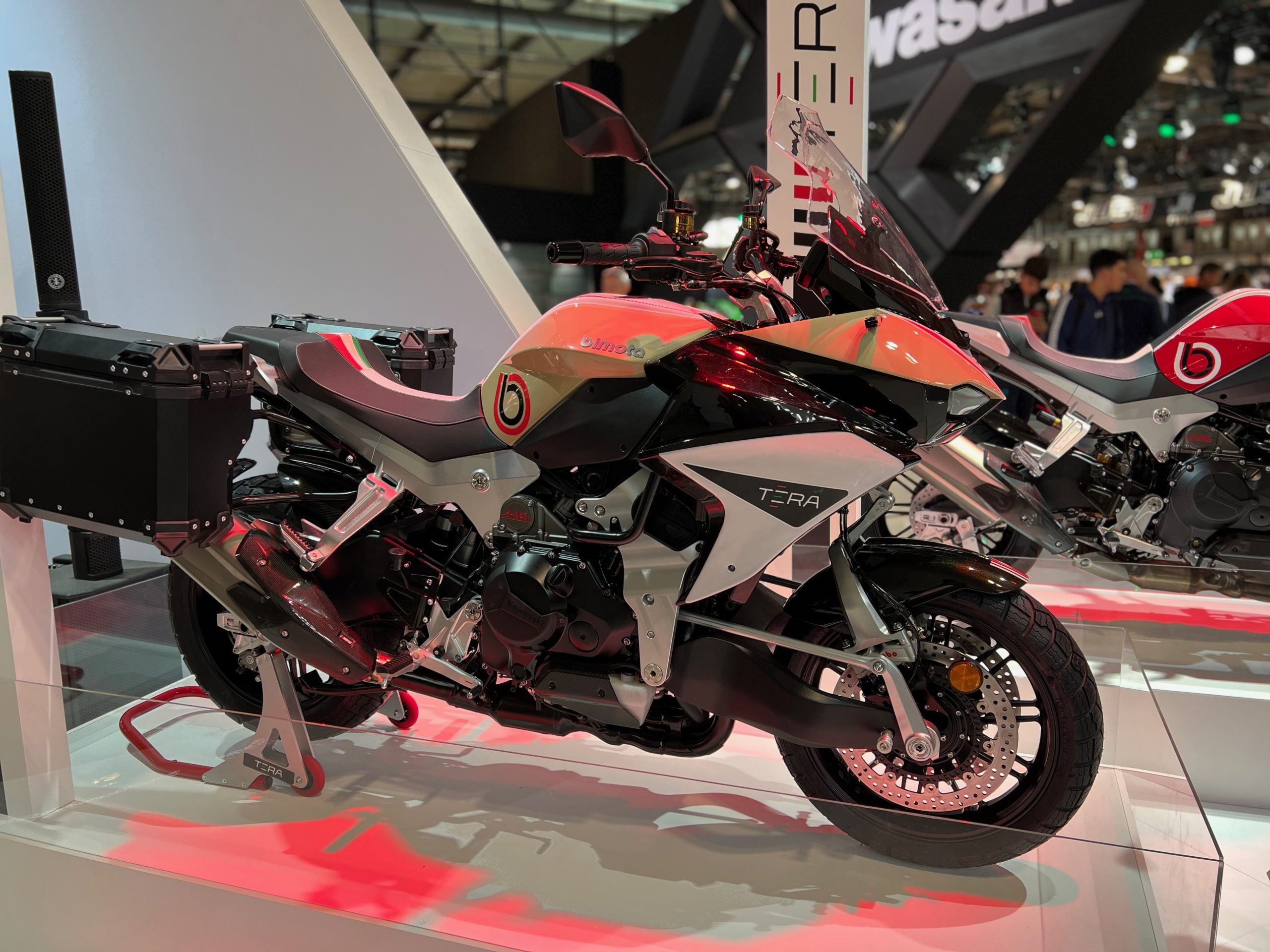
Bimota Tera with a set of hard panniers. Photo: William Roberson
Another “adventure bike” that stood out and wowed in person was the Bimota Tera, seen above in all its alt-front end glory. Now owned partially by Kawasaki, Bimota has solid financial footing at last and appears to be somewhat of a sandbox for ideas Kawi engineers would hesitate to introduce on their primary line of mass-production machines. But on the small-batch Bimotas? How about center-hub front steering with a multi-link monoshock suspension that makes BMW’s Telelever look crude? Let’s do it!

A closer look at the Tesi-derived front end. Photo: William Roberson
The oddly appealing Tera is powered by the supercharged liter-class inline four from the Kawasaki H2 series of insanity machines, and has been slightly de-tuned to produce only 200 horsepower and 101 pound feet of torque, should you need to achieve supersonic velocity while out on the dusty trail. With under five inches of travel from the standard Öhlins suspension front and rear, it probably won’t work the best in a deep G-out, but opt for the onboard adjustable Marzocchi semi-active suspension couplet (bring your second wallet) and travel jumps to nearly 5.7 inches up front and 6.5 out back. Go ahead and send it!
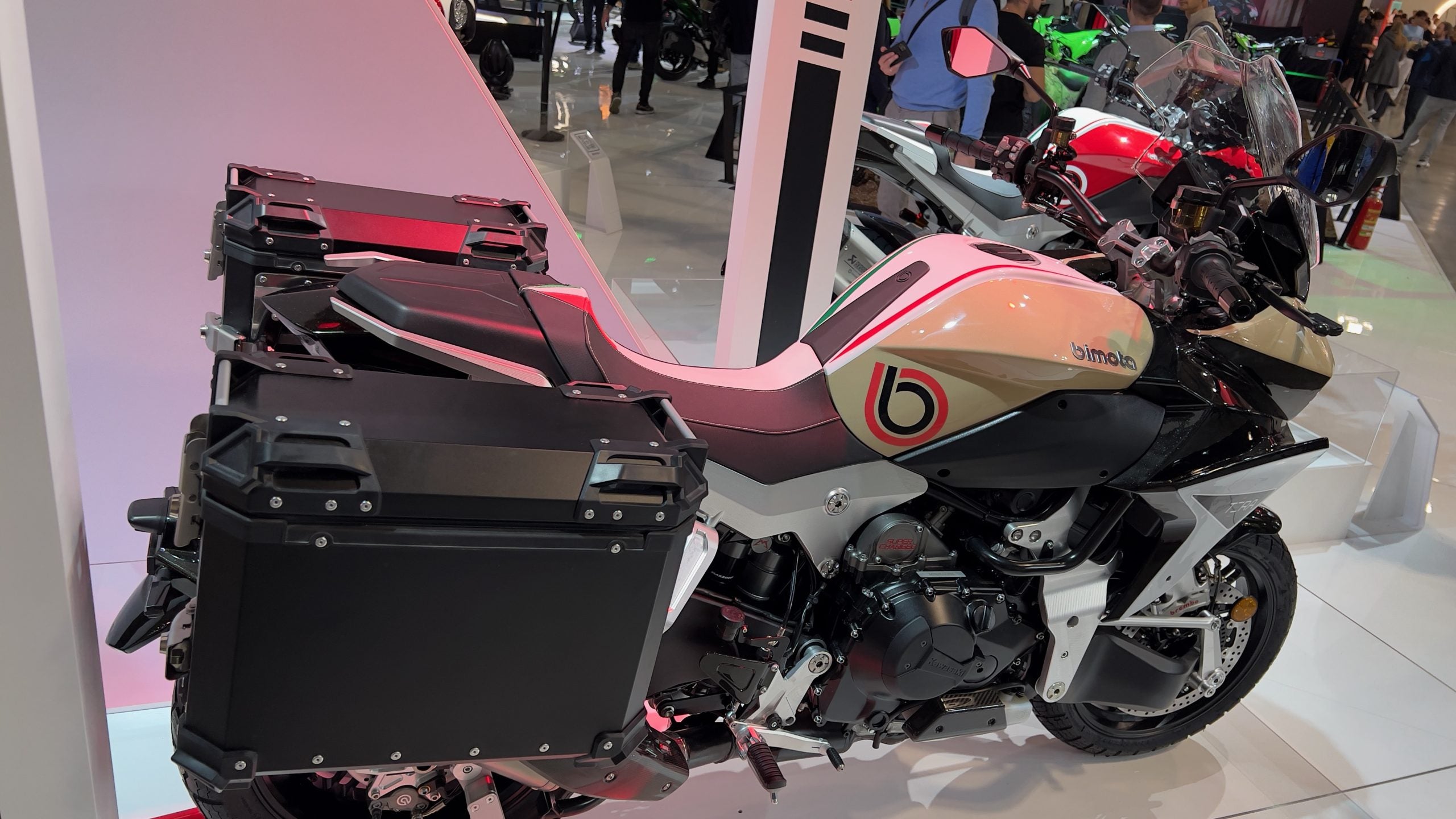
There’s no frame since the suspension bits bolt to the engine. Photo: William Roberson
But the reality is that like every Bimota ever produced, the vast majority will sadly be garage queens that see few miles (if any) let alone get ridden anywhere near a muddy forest road that might sully the paint or any shiny parts. Add all the aluminum panniers and spendy farkles you like, the Tera is a road bike first and likely one ridden sparingly at best. If you actually do see one out in the rough stuff, be sure to also keep an eye out for unicorns and UFOs as you go.
Away from the big brand platforms (Yamaha had a breakdance squad on a raised stage), there were many odd bits that caught my eye, like this ice-racing Vespa:
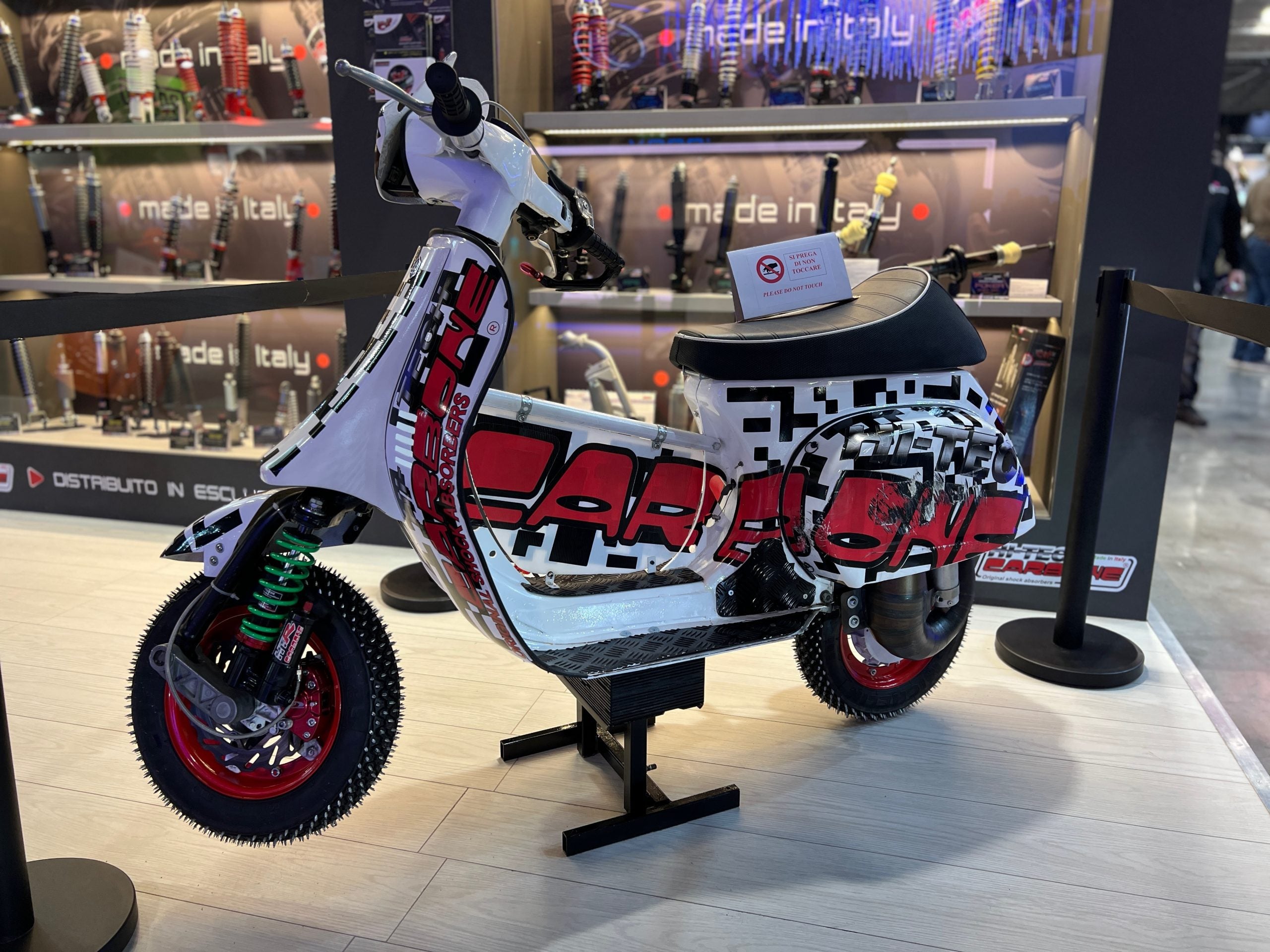
Traction won’t be a problem for this vintage Vespa, unless it’s on actual pavement. Photo: William Roberson
And this wild 125mph Senmenti X electric spaceship thing from Horwin:
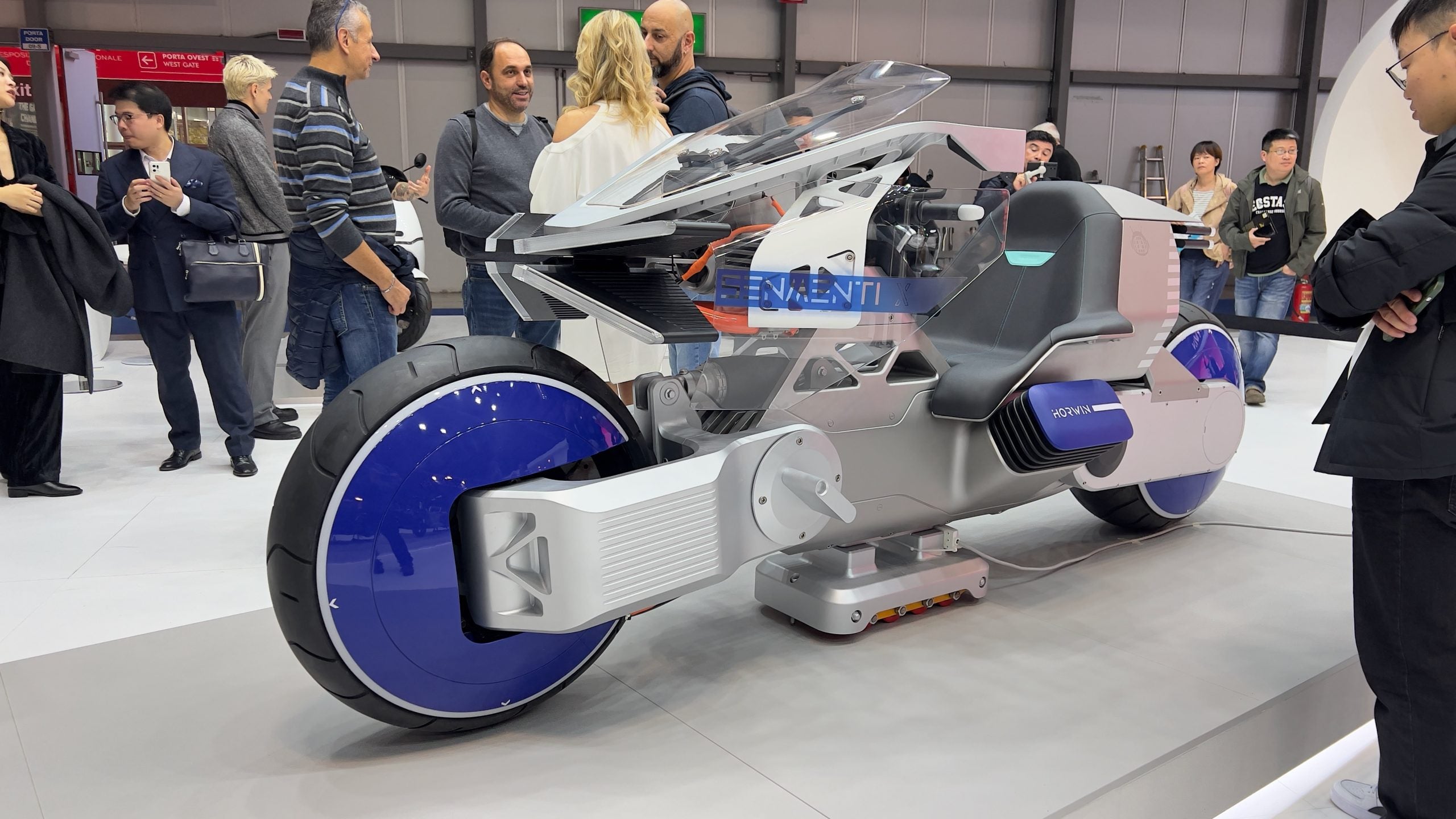
Horwin Senmenti X electric motorcycle prototype. Photo: William Roberson
This burly AJP PR7 650 Adventure dualsport looks ready to rock with some Öhlins bits. AJP is based in Portugal:
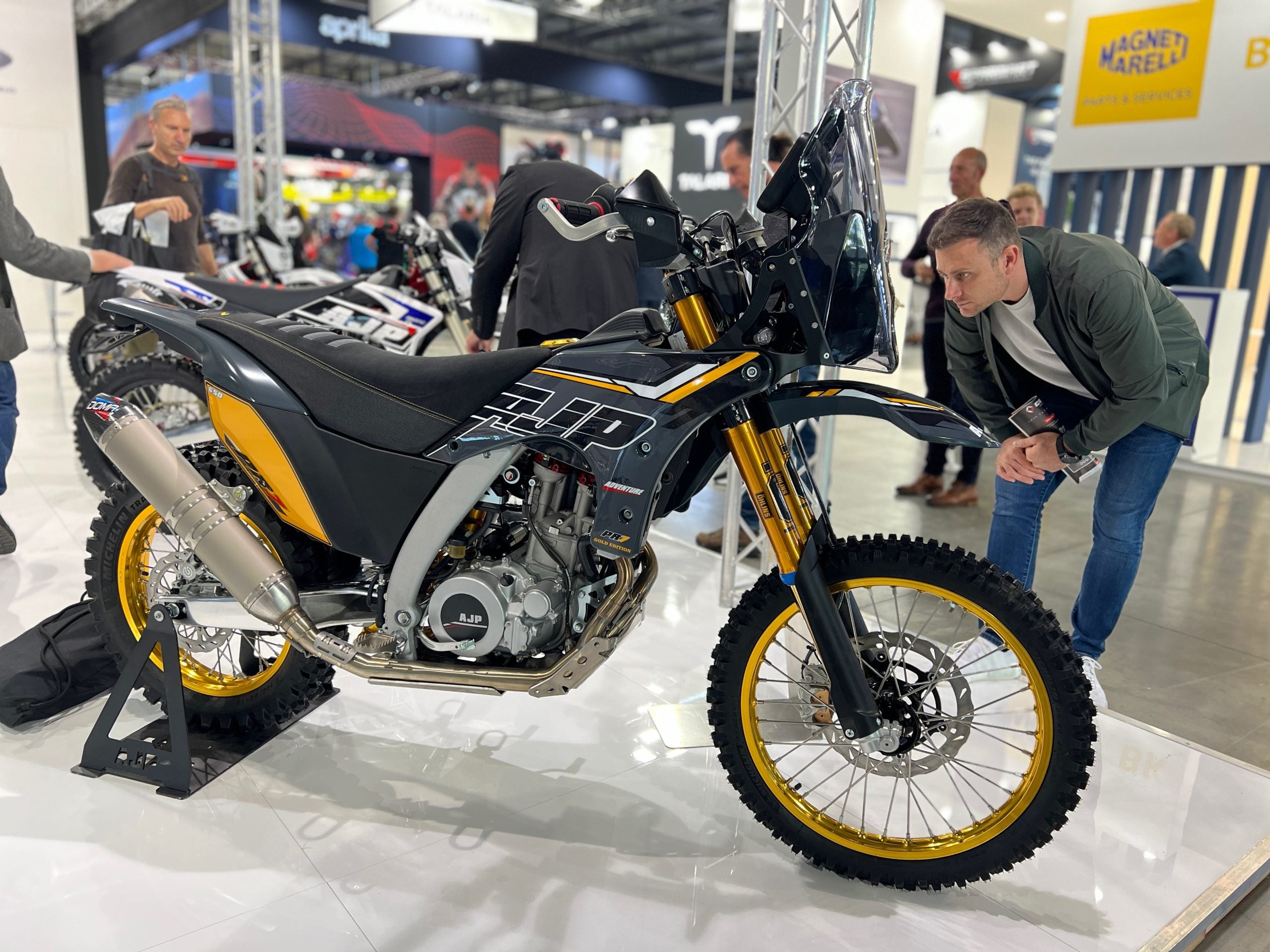
Photo: William Roberson
Moto Morini (now a Chinese brand) was on hand with some sweet rally-styled X-Cape models:

Photo: William Roberson
You could go pretend racing at the Aprilia paddock:
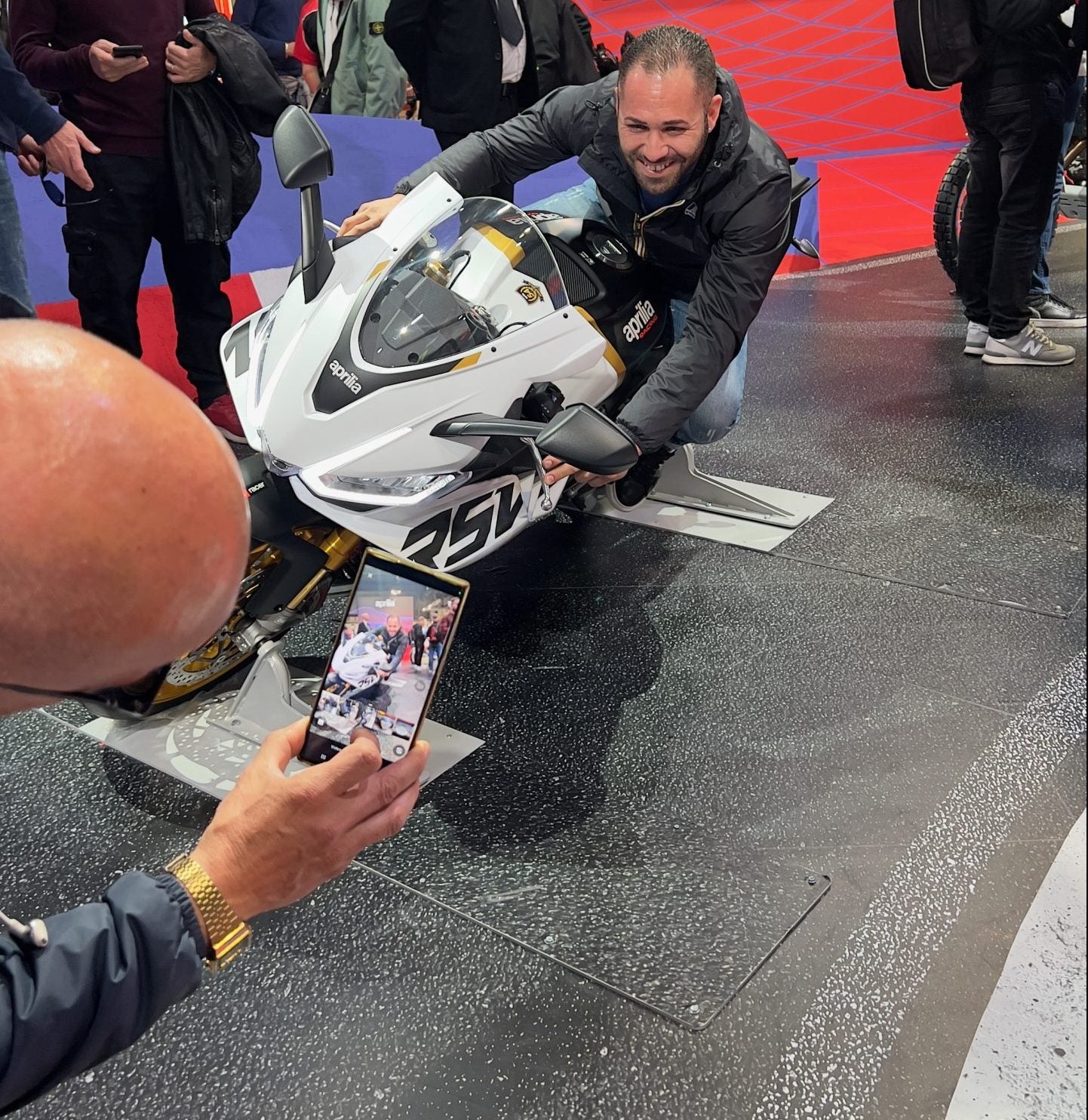
Photo: William Roberson
As a scooter rider (I own several) it was good to see historic icon Lambretta, now owned by a Swiss company, back in business with some classic but tech-modern models:
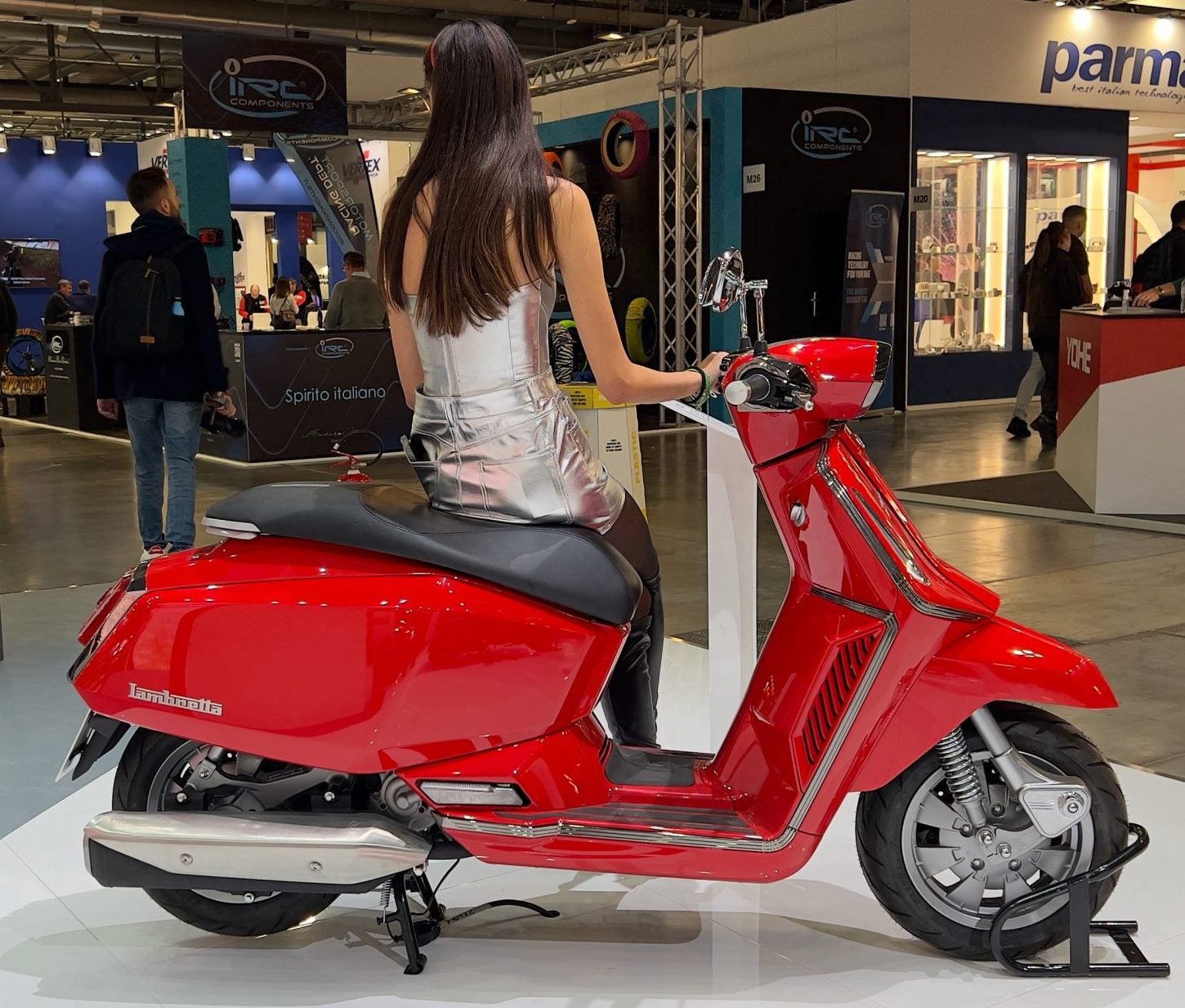
Photo: William Roberson
Another interesting scooter note: While electric motorcycles continue to try and get traction (sales) in the US, it seems electric scooters may be the perfect vehicle for two-wheeling on electrons. There were plenty on display at EICMA and I saw many being ridden on the streets of Milan, and key tech that makes them work is battery swapping, like so:
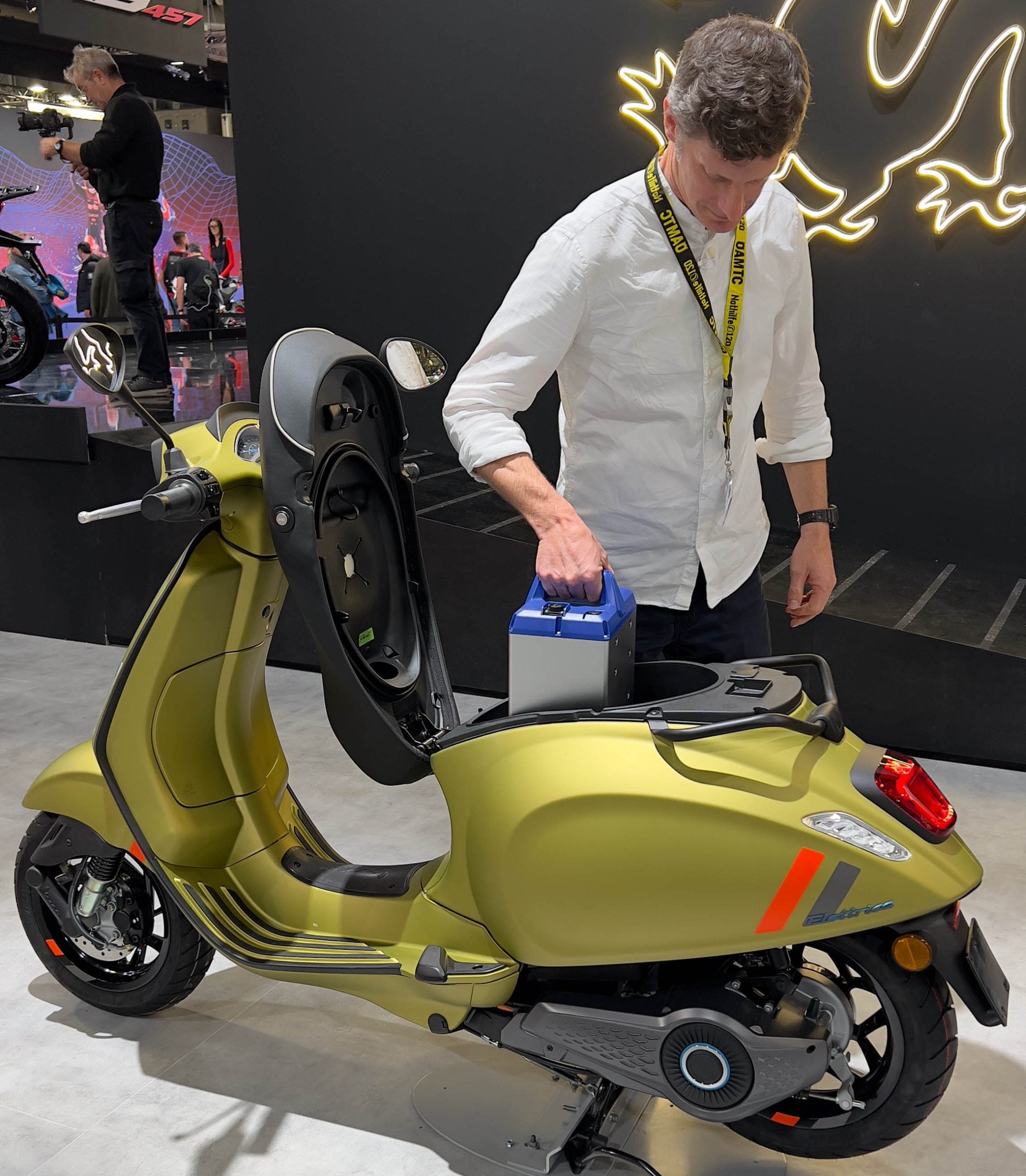
A demonstrator pulls a quick-swap battery from a scooter. Photo: William Roberson
Taiwan-based scooter and electric motorcycle maker KYMCO has announced a huge push to build out a large battery swapping network and showed off a line of sleek Ionex city scoots that use not one but two batteries for longer-range rides. Hey, I get it if you’re not a scoot jockey, but it’s literally how billions of people get around in most parts of the world.
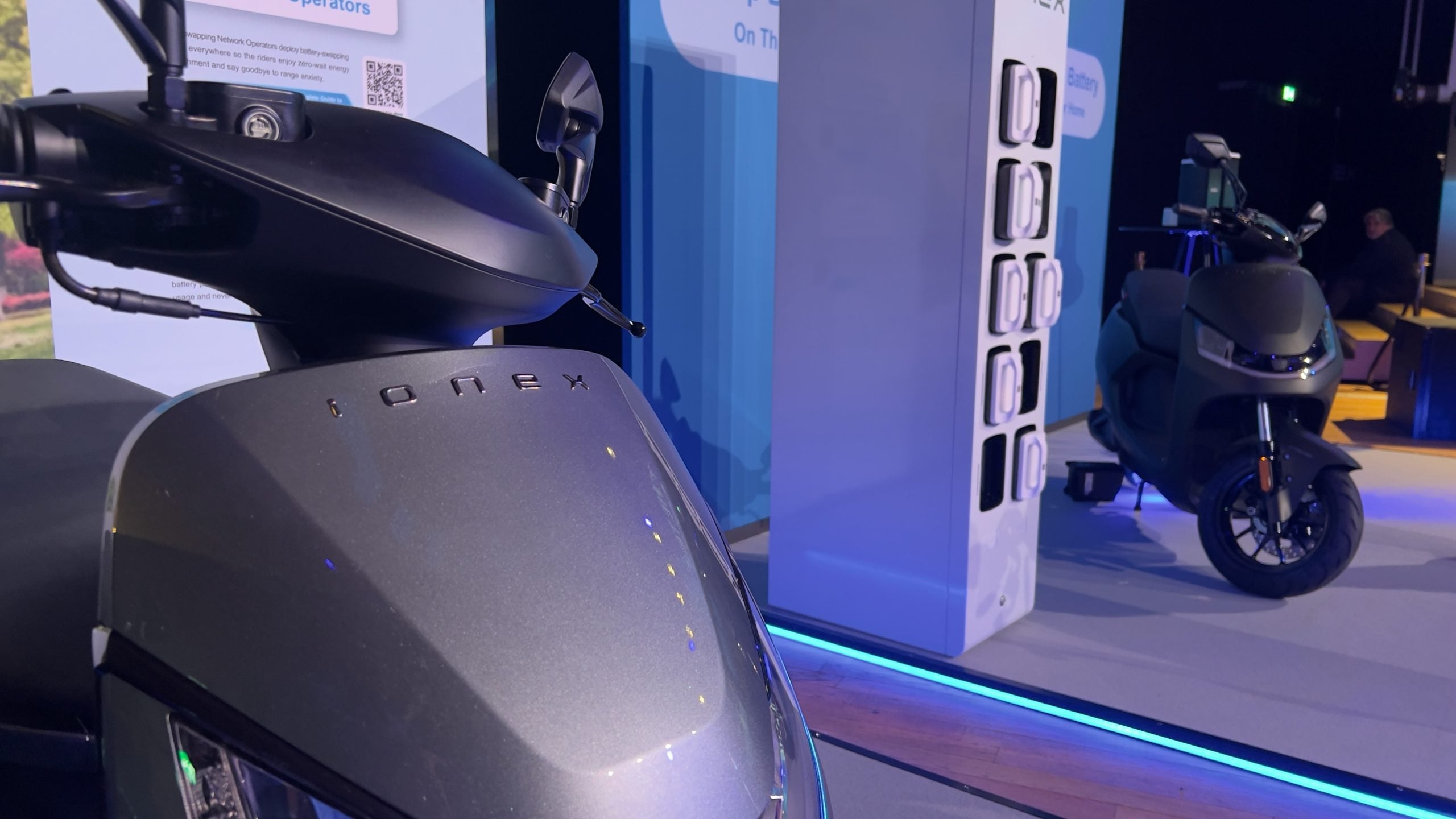
A KYMCO battery swap station and electric scooters. Photo: William Roberson
It takes literally 15 seconds to change out the batteries at one of their self-serve kiosks (I tried it out, above). It’s a strategy that works great for scooters, but really doesn’t work (yet) for full-size electric motorcycles that use much larger, much heavier batteries. Tesla showed off a battery-swap system for its cars a decade ago that took 90 seconds to complete (using robotics, of course), but nothing ever came of it. But for scooters it seems like a home run—at least in Europe and Asia.
Still wandering the halls, I came across this camping setup that made smart use of some hard panniers:
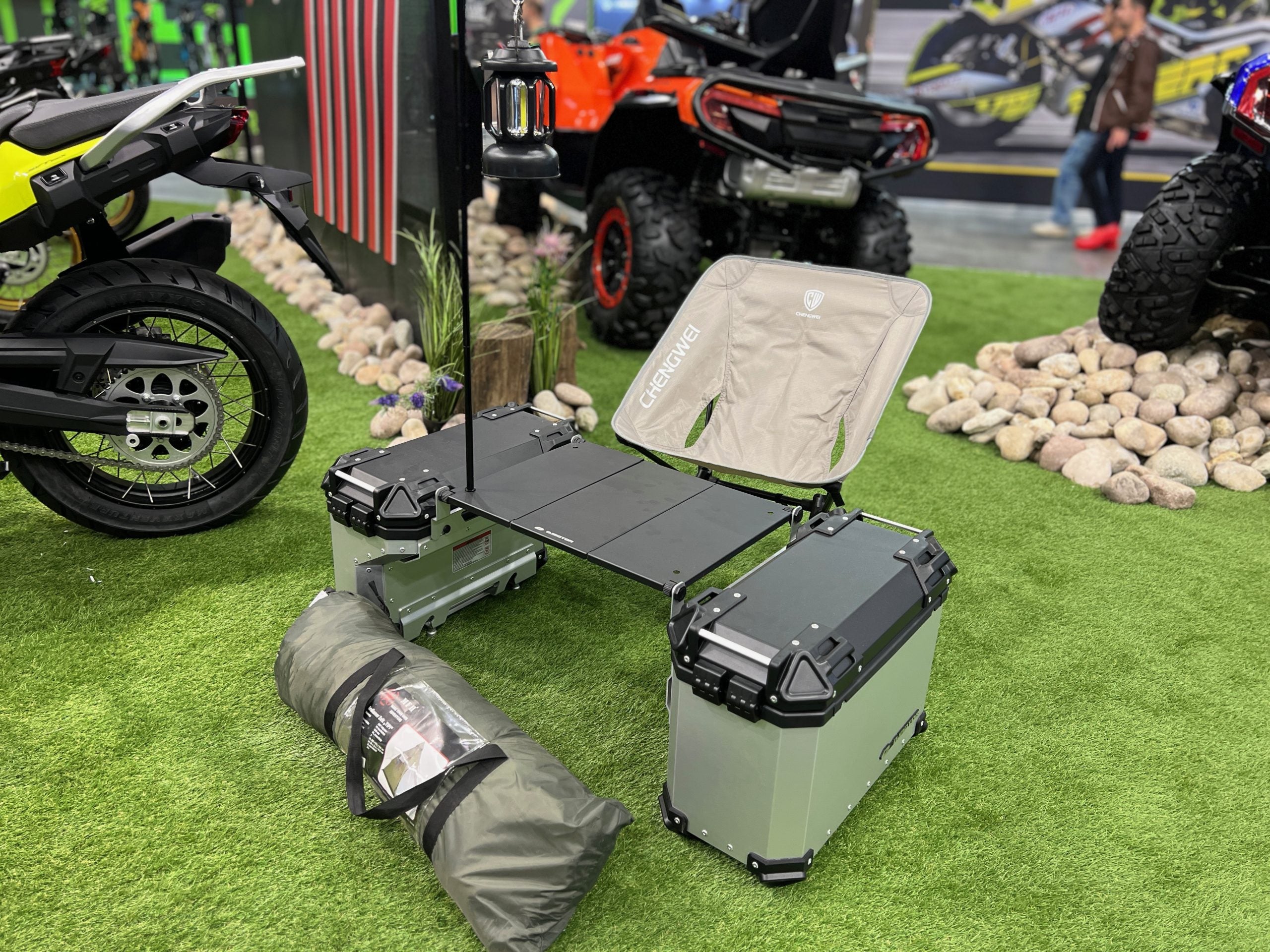
Photo: William Roberson
A very courageous rider, Sinje Gottwald, recently rode this Cake electric bike across the whole of Africa (we have her story in the next print issue of the ADVrider magazine):

Photo: William Roberson
Benelli, also now a Chinese company, showed off its sharp 502X adventure machine:

Photo: William Roberson
If you’re looking for a somewhat unique helmet and are a fan of the crazy Squid Game series on Netflix, HJC has you covered. Looks like someone liked the idea so much they made off with a demo unit:

Photo: William Roberson
Piaggio-owned Moto Guzzi had this lovely cafe V7 on display:
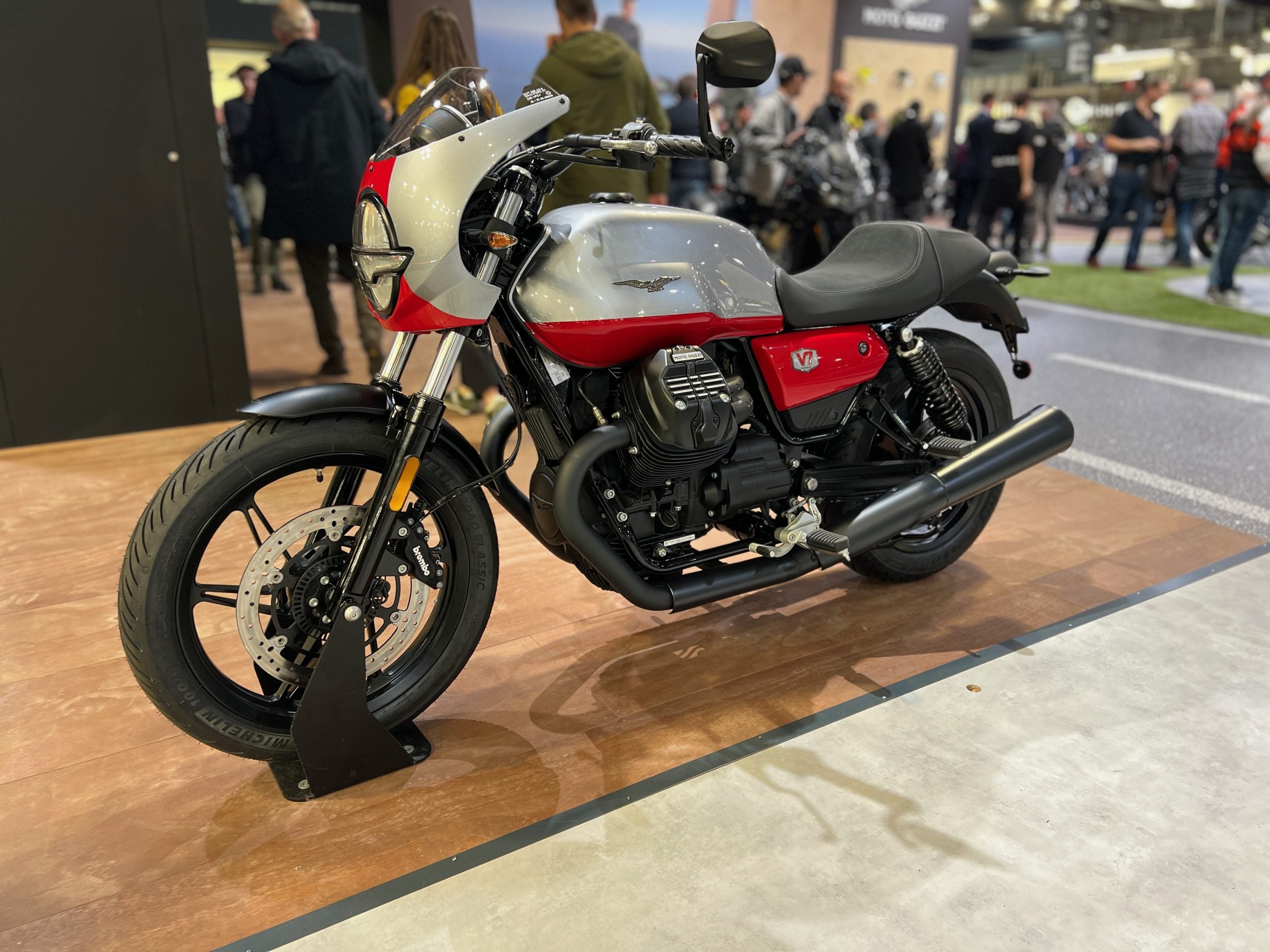
Photo: William Roberson
I walked the entire show, but this guy had the right idea with some inline skates and winter wear:
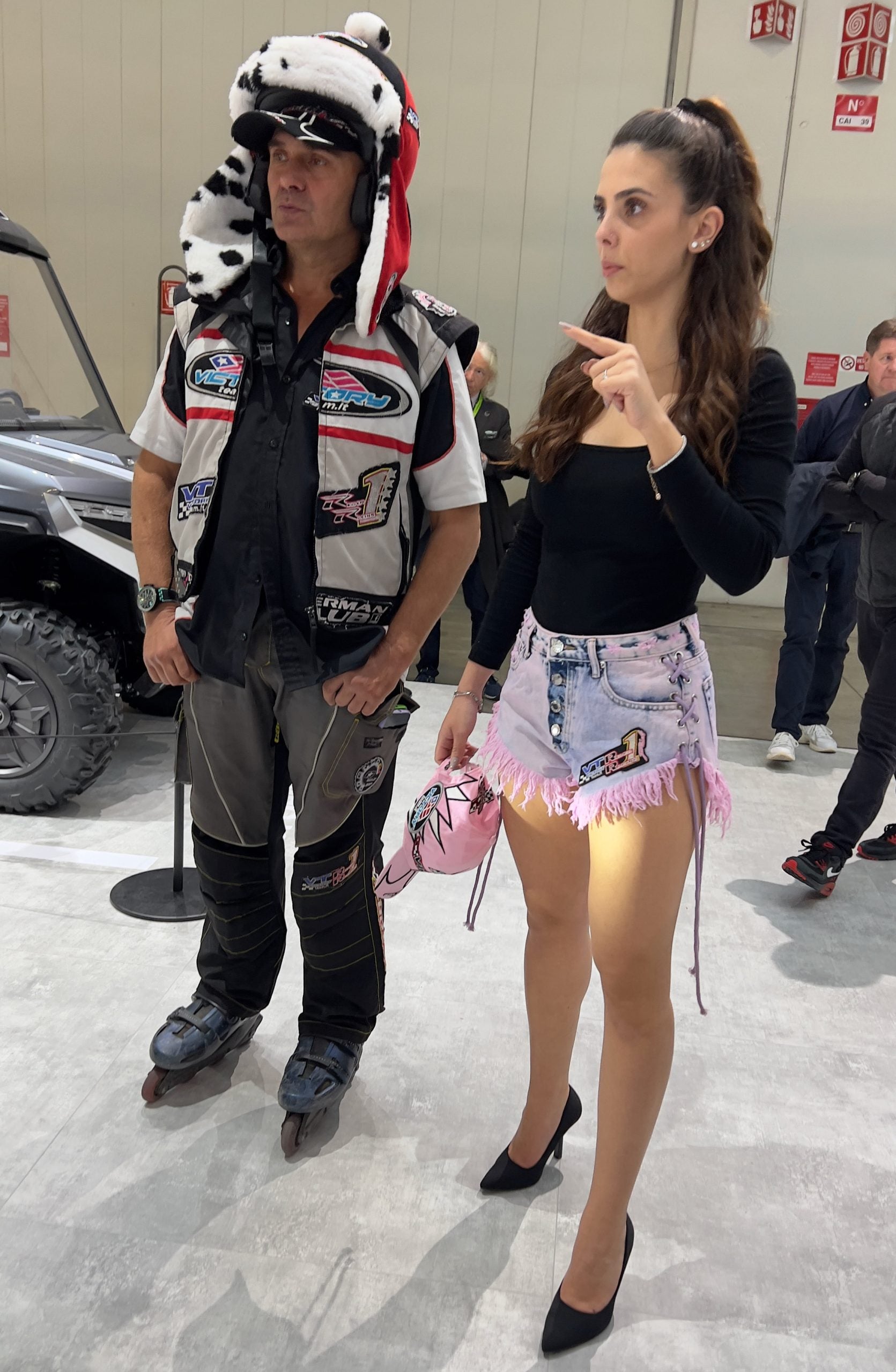
Photo: William Roberson
Yamaha brought all the fun Tenere T7 variants North America doesn’t get, like this World Rally model:

Photo: William Roberson
Taiwan-based scooter maker SYM is getting serious about the ADV scooter thing with its 399cc ADXTG:
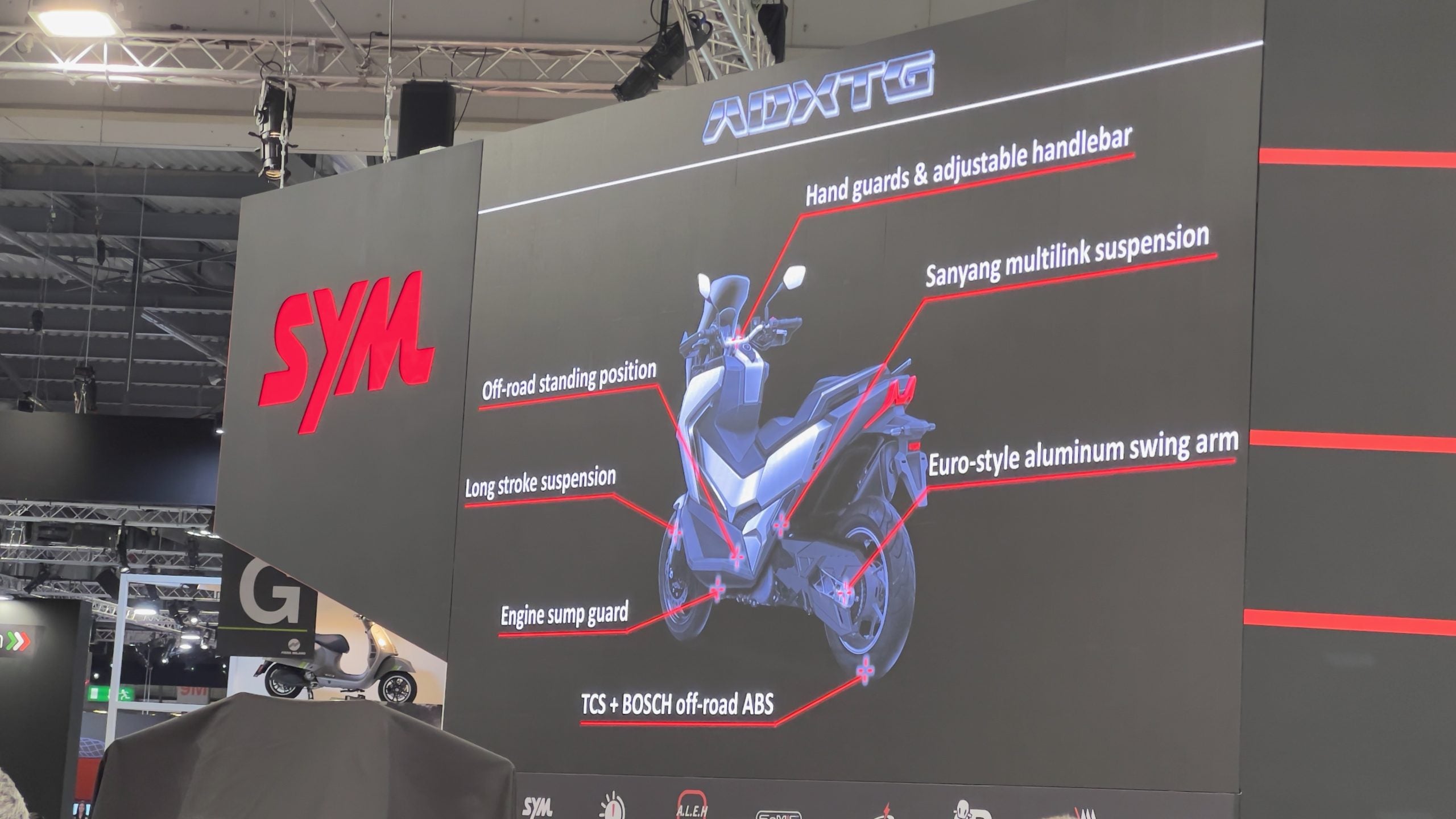
Photo: William Roberson
Yamaha needs to do the right thing and bring that XSR 900 Superbike homage to North America. Look how well I fit on it! Thanks for reading, everyone. Let’s see your comments below!

Photo: William Roberson






